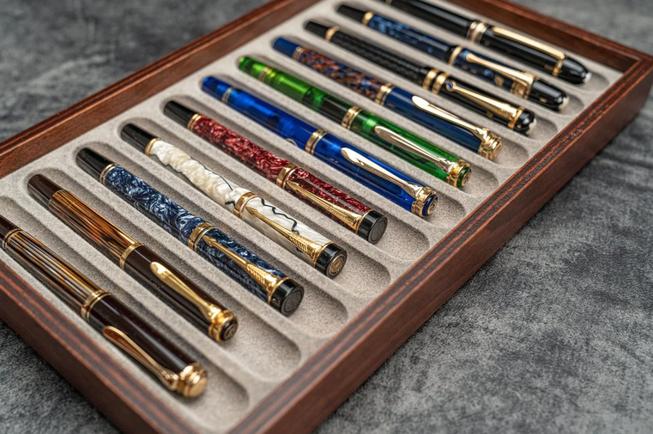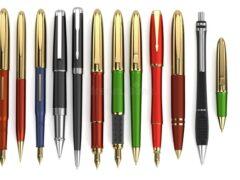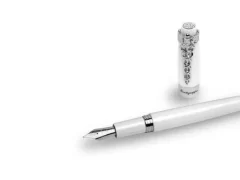
Why luxury pens? Starting Your Own Luxury Pen Collection
Luxury pens are not just writing instruments; they are a symbol of sophistication, status, and personal style. Collecting luxury pens can be an enjoyable and rewarding hobby, with numerous benefits and a variety of pen types to explore.
Benefits of collecting luxury pens
As a collector, you can appreciate the craftsmanship, design, and history behind each luxury pen. Luxury pens are often made of high-quality materials and exhibit meticulous attention to detail. They can also be an excellent investment, as the value of some pens appreciates over time. Additionally, collecting luxury pens can lead to a deeper understanding of various cultures and artistic styles, as pen makers draw inspiration from different regions and eras.
Common types of luxury pens
Luxury pens come in various types, including fountain pens, rollerball pens, and ballpoint pens. Fountain pens are often considered the most prestigious, with their elegant design and smooth writing experience. Rollerball pens offer a fluid writing experience similar to a fountain pen but are more convenient and low-maintenance. Ballpoint pens are known for their reliability and durability, with a wide range of luxury options available.
Understanding the Basics of Starting Your Own Luxury Pen Collection
What to Look for in a luxury pen
When selecting a luxury pen, consider the materials, craftsmanship, design, and brand reputation. The quality of materials, such as the metal or resin used for the body, the nib, and the ink system, is essential for durability and performance. The pen’s design should be visually appealing and comfortable to hold, with a balance between aesthetics and functionality. Brand reputation can also be a significant factor, as established luxury pen makers often have a history of producing high-quality, reliable pens.
Factors that determine the value of a pen
Several factors contribute to a luxury pen’s value, including rarity, materials, craftsmanship, and condition. Limited edition pens, those made from precious materials, or those with intricate designs can command higher prices. Additionally, the pen’s condition and the presence of original packaging or documentation can significantly impact its value.
Understanding pen nibs, ink, and refills
The nib is the metal tip of a fountain pen and plays a crucial role in the writing experience. Nibs come in various sizes and materials, with gold or stainless steel being the most common. Ink systems can vary, with options like cartridge, converter, or piston filling systems. Rollerball and ballpoint pens also have different refill options, with varying ink types and tip sizes.
Selecting Your First Luxury Pen When Starting Your Own Luxury Pen Collection
Budgeting for a luxury pen collection
Establishing a budget is essential when starting a luxury pen collection. Consider the initial cost of purchasing a pen and the ongoing expenses for maintenance, ink, and refills. It’s wise to begin with a more modest budget, gradually expanding as your knowledge and interest grow.
Entry-level luxury pens for beginners
Many entry-level luxury pens offer excellent value and quality. Brands like Lamy, TWSBI, and Pilot produce reliable and stylish pens that are perfect for those new to collecting. These pens provide a taste of luxury without breaking the bank.
Mid-range luxury pens for collectors
Mid-range luxury pens can offer a more refined writing experience, with brands like Montblanc, Pelikan, and Sailor. These pens often feature higher-quality materials, improved craftsmanship, and a more extensive range of designs and finishes.
Building Your Collection When Starting Your Own Luxury Pen Collection
Identifying and acquiring rare pens
As your collection grows, you may develop an interest in rare and unique pens. These can include vintage pens, limited editions, or those with historical significance. Researching the history and features of specific models can help you identify valuable pens. You can acquire rare pens through auctions, antique shops, pen shows, or online marketplaces.
Collecting limited edition pens
Limited edition pens are often highly sought after by collectors due to their rarity and unique designs. Pen manufacturers may release limited editions to celebrate milestones, anniversaries, or special events. To stay informed about upcoming releases, follow luxury pen brands on social media, join online forums, or subscribe to newsletters.
Building a theme for your collection
Creating a theme for your collection can make it more cohesive and enjoyable to pursue. Themes can be based on pen types, materials, brands, or even specific design elements. A themed collection can help you focus your efforts and develop a deeper understanding of your chosen niche.
Taking Care of Your Luxury Pens When Starting Your Own Luxury Pen Collection
Proper storage and maintenance
Proper storage is essential to preserve the value and functionality of your pens. Store them in a cool, dry place away from direct sunlight or extreme temperatures. Regular maintenance, such as cleaning the nib and ink system, is crucial for maintaining a pen’s performance. Consult the manufacturer’s guidelines for proper care and maintenance.
Cleaning and restoring pens
Cleaning and restoring pens can help preserve their value and appearance. Regular cleaning is essential for preventing ink clogs and maintaining optimal performance. For vintage or damaged pens, consider seeking the help of a professional restorer to ensure the pen is properly repaired and preserved.
Preserving the value of your collection
To preserve the value of your collection, keep pens in their original packaging and retain any documentation, such as certificates of authenticity. Regular maintenance and proper storage will also protect your pens from damage and deterioration.
Displaying Your Collection When Starting Your Own Luxury Pen Collection
Choosing the right display case
A suitable display case is essential for showcasing your collection and protecting it from dust and damage. Consider factors like size, materials, and design when selecting a case. Glass or acrylic cases are popular choices for their visibility and durability.
Creative ways to showcase your pens
There are numerous creative ways to display your collection, such as wall-mounted pen racks, custom-made pen stands, or even repurposing vintage furniture. Consider the overall aesthetic and theme of your collection when choosing a display method.
Tips for organizing and labeling your collection
Organizing and labeling your collection can make it easier to navigate and appreciate. Group pens by brand, type, or theme, and use labels or tags to provide essential information, such as model names, release dates, or unique features.
Understanding the Market When Starting Your Own Luxury Pen Collection
Popular pen brands and manufacturers
Some popular luxury pen brands include Montblanc, Pelikan, Sailor, Visconti, and Graf von Faber-Castell. These manufacturers are known for their high-quality materials, craftsmanship, and innovative designs. Each brand has a unique history and style, catering to a range of collector preferences.
Auctions, shows, and online marketplaces
Auctions, pen shows, and online marketplaces offer opportunities to buy, sell, and trade luxury pens. Auction houses often feature rare and valuable pens, while pen shows provide a chance to meet fellow collectors and learn from experts. Online marketplaces like eBay and specialized pen forums can be a convenient way to find specific models or deals.
Identifying fakes and forgeries
Unfortunately, the luxury pen market is not immune to fakes and forgeries. To protect yourself, research the features and hallmarks of authentic pens, and always buy from reputable dealers or sources.
Familiarize yourself with common counterfeit indicators, such as incorrect logos, poor-quality materials, or unusual packaging. If a deal seems too good to be true, it likely is.
Conclusion – Starting Your Own Luxury Pen Collection
Recap of key points
In this guide, we have covered the basics of starting a luxury pen collection, including understanding the different types of pens, the factors that determine their value, and selecting your first luxury pen.
We also discussed building a cohesive collection by focusing on a theme, acquiring rare and limited edition pens, and understanding the market for luxury pens. Proper care, storage, and display methods will ensure your collection remains in optimal condition.
By following these tips and guidelines, you’ll be well on your way to creating a beautiful and valuable luxury pen collection.
Encouragement to start your own luxury pen collection
Embarking on the journey of collecting luxury pens can be an incredibly rewarding and fulfilling hobby. As you delve into the fascinating world of pens, you’ll develop a deeper appreciation for the artistry, craftsmanship, and history behind these writing instruments.
Your collection can become a reflection of your personal tastes and interests, as well as a source of pride and enjoyment. So, gather your resources, set your budget, and begin your adventure into the captivating world of luxury pen collecting. The perfect pen is waiting for you.
FAQ
What are some reputable luxury pen brands to consider for Starting Your Own Luxury Pen Collection?
There are many reputable luxury pen brands to consider for starting a collection. Here are some popular brands that are highly regarded by pen enthusiasts:
1. Montblanc – A German luxury brand that is renowned for its craftsmanship, elegant designs, and use of high-quality materials.
2. Pelikan – A German company that has been producing high-quality pens since 1838, known for its innovative designs and attention to detail.
3. Waterman – A French brand that has been crafting exquisite writing instruments since 1883, known for its sophisticated designs and precision engineering.
4. Parker – A British brand that has been producing high-quality pens since 1888, known for its classic designs and reliable performance.
5. Visconti – An Italian brand that is known for its bold and distinctive designs, use of premium materials, and exceptional craftsmanship.
6. Aurora – An Italian brand that has been crafting exquisite pens since 1919, known for its elegant designs and use of precious materials.
7. Sailor – A Japanese brand that is highly regarded for its precision engineering, smooth nibs, and beautiful designs.
8. Lamy – A German brand that offers a range of high-quality pens with innovative designs, excellent performance, and affordability.
9. Cross – An American brand that is known for its classic and timeless designs, use of premium materials, and exceptional craftsmanship.
10. Faber-Castell – A German brand that is highly respected for its attention to detail, use of premium materials, and innovative designs that combine tradition with modernity.
How much should I expect to spend on my first luxury pen when Starting Your Own Luxury Pen Collection?
The cost of a luxury pen can vary widely depending on the brand, materials, and design. As a general guideline, a high-quality luxury pen can cost anywhere from several hundred to several thousand dollars.
For a first-time buyer, it’s a good idea to establish a budget based on personal preferences and intended use. It’s possible to find a well-crafted luxury pen for around $200-$300, which can offer excellent quality and durability without breaking the bank.
Some popular luxury pen brands offer entry-level models that are more affordable than their higher-end counterparts, making them a great option for first-time buyers. Additionally, purchasing a pre-owned luxury pen from a reputable dealer can be a more cost-effective way to acquire a high-quality writing instrument.
Ultimately, the amount a person should budget for their first luxury pen depends on their individual circumstances and priorities. It’s important to research different brands and models and to consider factors such as material quality, design, and functionality before making a purchase.
What are some key features to look for in a luxury pen when Starting Your Own Luxury Pen Collection?
When selecting a luxury pen, there are several key features to look for to ensure you get a quality writing instrument. Here are some of the key features to consider:
1. Material: Luxury pens are typically made from high-quality materials such as precious metals, fine woods, and high-quality resins. Look for a pen that is made from a durable material that will withstand everyday use.
2. Design: Luxury pens often feature a distinctive design that sets them apart from standard pens. Look for a pen with a unique and stylish design that fits your personal preferences.
3. Nib: The nib is the part of the pen that makes contact with the paper and is responsible for the writing quality. Look for a pen with a high-quality nib that is smooth, consistent, and precise.
4. Ink: The type of ink used in a pen can impact its performance and writing quality. Look for a pen with high-quality ink that flows smoothly and consistently.
5. Comfort: A luxury pen should be comfortable to hold and use for extended periods of time. Look for a pen with a comfortable grip and balanced weight distribution.
6. Brand: Luxury pen brands are known for their quality, craftsmanship, and design. Look for a pen from a reputable brand that has a track record of producing high-quality writing instruments.
By considering these key features when selecting a luxury pen, you can ensure that you get a high-quality writing instrument that meets your needs and preferences.
How do I care for my luxury pen collection to ensure its longevity when Starting Your Own Luxury Pen Collection?
Proper care and maintenance are essential for keeping your luxury pen collection in excellent condition and ensuring its longevity. Here are some tips for caring for your luxury pen collection:
1. Store pens properly: Store pens in a dry and cool place, away from direct sunlight and extreme temperatures. Use a pen case or pouch to protect them from scratches, dents, or other damage.
2. Clean pens regularly: Use a soft cloth or microfiber towel to clean the pen body and cap. Avoid using harsh chemicals or solvents that could damage the pen’s finish or material.
3. Clean pen nibs: Use a soft cloth or pen flush solution to clean the pen nibs. Gently rinse the nib under cool water and dry it with a soft cloth.
4. Use the pen regularly: Pens that are used regularly are less likely to clog or dry out. Use high-quality ink to ensure optimal performance and avoid using low-quality or non-recommended ink.
5. Handle pens with care: Handle pens with care to avoid dropping or damaging them. Avoid applying too much pressure when writing or pressing down too hard on the nib.
6. Service pens when necessary: If a pen is not writing smoothly or appears to be damaged, take it to a professional for repair or servicing.
7. Rotate pens: Rotating your pen collection and using different pens regularly can help prevent ink from drying out or clogging.
By following these tips, you can help keep your luxury pen collection in excellent condition and enjoy its performance and beauty for many years to come.
What are some common mistakes to avoid when Starting Your Own Luxury Pen Collection?
Starting a luxury pen collection can be an exciting and rewarding experience, but there are some common mistakes that collectors should avoid. Here are some things to keep in mind:
1. Focusing too much on brand names: While luxury pen brands are known for their quality and craftsmanship, it’s important not to overlook lesser-known brands that may offer similar quality at a more affordable price.
2. Overlooking vintage pens: Vintage pens can be highly sought after by collectors and offer a unique aesthetic and history that newer models may not have.
3. Not doing enough research: It’s important to do your research before investing in a luxury pen collection. Research different brands, models, and materials, and consult with experts to ensure you’re making an informed decision.
4. Neglecting proper care and maintenance: Luxury pens require proper care and maintenance to ensure their longevity and performance. Neglecting proper care and maintenance can result in damage or deterioration of the pens.
5. Focusing only on aesthetics: While aesthetics are an important consideration, it’s important not to overlook the functional aspects of a luxury pen, such as the nib, ink flow, and comfort.
6. Impulsive buying: Impulsive buying can result in purchasing pens that do not fit into your collection or are not suitable for your writing needs. Take the time to consider your collection goals and intended use before making a purchase.
By avoiding these common mistakes, you can build a high-quality and rewarding luxury pen collection that will bring you enjoyment for many years to come.
How do I identify a rare or valuable pen to add to my collection when Starting Your Own Luxury Pen Collection?
Identifying a rare or valuable pen can be a challenging task, but there are some factors to consider that can help you identify a pen of significant value. Here are some things to look for:
1. Limited edition or discontinued models: Limited edition or discontinued models can be highly sought after by collectors and may command a higher price.
2. Rarity: Pens that were produced in limited quantities or have unique or rare features can be more valuable than mass-produced pens.
3. Historical significance: Pens that were used or owned by famous individuals, or have historical significance, can be highly valuable.
4. Material: Pens made from precious metals or rare materials, such as ivory or tortoise shell, can be more valuable than pens made from more common materials.
5. Brand: Certain luxury pen brands are known for their quality, craftsmanship, and history, and may command a higher price.
6. Condition: Pens that are in excellent condition and have been well-maintained may be more valuable than pens that show signs of wear or damage.
7. Documentation: Pens that come with original packaging, paperwork, or authentication certificates can be more valuable than those without documentation.
Identifying a rare or valuable pen requires careful research, evaluation, and expertise. Consulting with a pen expert or appraiser can help you identify pens of significant value and ensure you make informed decisions when adding to your collection.
What are some popular types of luxury pens to collect while Starting Your Own Luxury Pen Collection?
There are many different types of luxury pens that collectors may find appealing, depending on personal preferences and collection goals. Here are some popular types of luxury pens to consider collecting:
1. Fountain pens: Fountain pens are a classic type of luxury pen and offer a unique writing experience with their smooth and fluid ink flow. They can range from entry-level models to high-end limited editions.
2. Ballpoint pens: Ballpoint pens are a popular type of luxury pen that offers smooth and reliable ink flow. They are often more practical and convenient for everyday use than fountain pens.
3. Rollerball pens: Rollerball pens offer a hybrid experience between fountain pens and ballpoint pens, with a smooth ink flow that is not as wet as fountain pens but still offers a nice writing experience.
4. Limited edition pens: Limited edition pens are highly sought after by collectors and can come in various types, such as fountain pens, ballpoint pens, and rollerball pens. These pens are produced in limited quantities and often feature unique designs or rare materials.
5. Vintage pens: Vintage pens can offer a unique aesthetic and history that newer models may not have. They can come in various types, including fountain pens, ballpoint pens, and rollerball pens.
6. Luxury pen sets: Luxury pen sets, which can include fountain pens, ballpoint pens, and rollerball pens, offer a complete writing experience and can be highly valued by collectors.
By considering these popular types of luxury pens, collectors can find a niche that suits their interests and preferences and build a unique and rewarding pen collection.
How do I store my luxury pen collection to protect it from damage when Starting Your Own Luxury Pen Collection?
Proper storage is essential for protecting your luxury pen collection from damage and deterioration. Here are some tips for storing your luxury pens:
1. Store pens in a dry and cool place: Avoid storing pens in areas with high humidity or fluctuating temperatures, as this can cause damage to the pen’s materials and ink.
2. Use a pen case or pouch: A pen case or pouch can protect your pens from scratches, dents, or other damage. Choose a case or pouch made from high-quality materials that provide sufficient protection for your pens.
3. Avoid direct sunlight: Direct sunlight can cause fading or discoloration of the pen’s materials, so it’s important to store pens in a shaded area.
4. Store pens upright: Storing pens upright can prevent ink from settling at the bottom of the pen, which can cause clogging or damage to the nib.
5. Keep pens away from magnets: Magnets can damage the nib of a fountain pen, so it’s important to store pens away from any magnetic sources.
6. Rotate pens regularly: Rotating your pen collection and using different pens regularly can help prevent ink from drying out or clogging.
7. Avoid storing pens with other objects: Storing pens with other objects can cause damage to the pen’s materials or ink, so it’s important to store pens separately.
By following these tips, you can ensure that your luxury pen collection is properly stored and protected from damage or deterioration.
Where can I find resources and expert advice when Starting Your Own Luxury Pen Collection?
There are many resources and experts available to provide advice and guidance on starting a luxury pen collection. Here are some options to consider:
1. Pen forums: Pen forums are online communities of pen enthusiasts who share information, tips, and advice on collecting and using luxury pens. Joining a forum can be a great way to connect with other collectors and gain valuable insights.
2. Pen blogs: There are many pen blogs and websites that provide reviews, news, and resources on luxury pens. These blogs can offer a wealth of information on different brands, models, and features to consider when starting a collection.
3. Pen shows: Pen shows are events where collectors and pen enthusiasts come together to buy, sell, and trade pens. Attending a pen show can be a great way to meet experts in the field, view rare and unique pens, and learn more about the world of luxury pen collecting.
4. Pen stores: Specialty pen stores often have knowledgeable staff who can offer advice and guidance on starting a collection. They may also offer pen customization services, repairs, and maintenance tips.
5. Pen experts: There are professional appraisers and experts who specialize in luxury pen collecting and can provide personalized advice and guidance on starting a collection. Consulting with an expert can be particularly helpful when considering high-value or rare pens.
By leveraging these resources and seeking expert advice, you can gain valuable insights and guidance on starting a luxury pen collection and building a high-quality and rewarding collection.
Disclosure: As an Amazon Associate, I earn from qualifying purchases at no extra cost to you.










